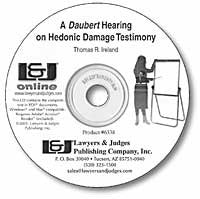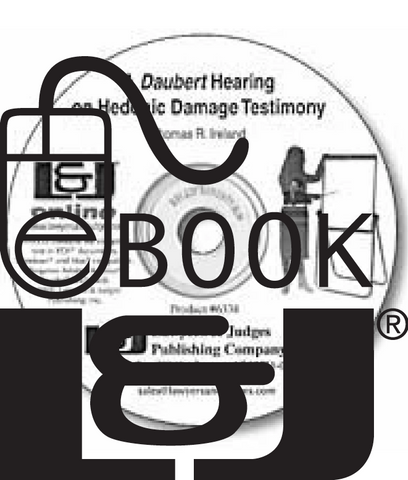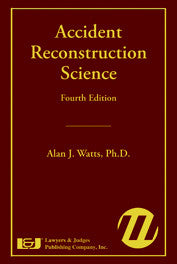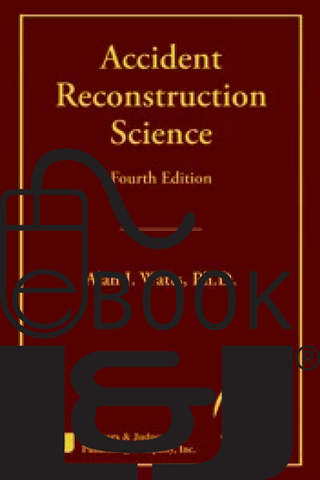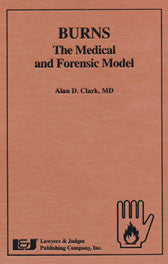
Burns - The Medical and Forensic Model
- Editor: Alan D. Clark; Contributors: Laura Billon, John Brick, Raymond M. Fish, R. Tom Glass, Paul Anthony Janson, William R. Reynolds, Crystal R. Samborski,
- ISBN 10: 1-930056-59-1
- ISBN 13: 978-1-930056-59-6
- Copyright Date Ed: January 31, 2006
- Pages: 368 pages
- Binding Information: Casebound
- Size: 6 ✕ 9 Inches (US)
The totality of burn injury – personal and economic – is enormous. From a neighborhood house fire to the collapse of the Twin Towers, burn injuries have continued to affect society especially burn victims and their families. For the medical, forensic and legal professions, burn care continues to be viewed by many as part science and part myth. The medical science of burn treatment and rehabilitation has progressed rapidly, dispelling many of the myths, and the legal issues have changed as well.
This book provides a rapid, concise treatise on the ramifications of burn injury–from electrical injury to thermal and blast injury. Forensic considerations are presented consistently throughout the text, both in the medical and forensic sections. The medical sections provide essential information on many facets of burn injury and care, including burn characteristics, evaluation and treatment including pre hospitalization care, critical care, and rehabilitation, toxicology and physiology, hidden toxic dangers, and planning for disasters where there are many people injured, including building explosions and terrorist attacks. The forensic sections cover diverse topics such as fire and arson investigation, identification of burn victims, fire death investigation and advanced forensic considerations in electrothermal burns.
This book is essential for anyone in the legal, law enforcement, and/or health care professions, involved with burn cases.
This book is also available as an E-book. Click here to purchase and download:
Topics include
- Characteristics of skin burns
- Pre-hospital evaluation and treatment
- Emergency department management
- Critical care for severe burn injuries
- Rehabilitation
- Burn care planning for major disasters including building explosions and terrorist attacks
- Fire and arson investigation
- Victim identification
- Fire death investigation
- Interaction of toxicology and physiology
- Hidden toxic dangers
- Advanced forensic considerations in electrothermal burns
Table of Contents
Part One: Medical Basics
Chapter 1: Characteristics of Skin Burns
1.1 Introduction
1.2 General Appearance of Burns from an Electrical Source
1.3 Degrees of Thermal and Electrical Burns
1.4 Gross and Microscopic Examination of Electrical Current Marks
A. Current marks: may not be present
B. Cyanosis
C. Easily overlooked lesions
D. Electric channels
E. Arc burns with sharp demarcation
F. Skin metallization
1.5 Difficulty of Determining Extent of Deep Injury Related to Thermal and Electrical Burns
1.6 Factors Related to the Formation of Burns
A. Changes in skin resistance over time
B. Enlargement of burns over time
C. Firm versus intermittent contact
D. High voltage burns <brE. Postmortem burns
1.7 Conclusions
Chapter 2: Pre-Hospital Evaluation and Treatment
2.1 Introduction
A. Burn characteristics and pre-hospital care
B. Burn management considerations in the pre-hospital setting
2.2 Initial Assessment
2.3 Extent of Injury
2.4 Depth of Injury
2.5 Site of Injury
2.6 Coexistent Injuries
2.7 Initial Evaluation and Transport
2.8 Smoke Inhalation
2.9 Chemical and Radiation Burns
2.10 Electrical Burns in the Pre-Hospital Setting
2.11 Summary
Chapter 3: Emergency Department Management
3.1 The Emergency Department Paradigm
3.2 Plane Crash—Major Burn Injury
A. History and examination
B. Forensic considerations
C. Treatment
3.3 Childhood Scald and Thermal Injury
A. History and examination
B. Forensic considerations
C. Treatment
3.4 Explosion
A. History and examination
B. Forensic considerations
C. Treatment
3.5 Electrical Injury
A. History and physical examination
B. Forensic considerations
C. Treatment
3.6 Chemical Burn
A. History and physical examination
B. Forensic considerations
C. Treatment
3.7 Conclusion
Chapter 4: Critical Care for Patients with Severe Burn Injury
4.1 Introduction
4.2 Critical Care Center Design in the Burn Center
A. Staffing
B. Administration
4.3 Ongoing Resuscitation
4.4 Abdominal Compartment Syndrome
4.5 Oxygenation/Ventilation
A. Hypoxemia
B. Ventilation
C. Non-invasive mechanical ventilation
D. Mechanical ventilation
4.6 Nutrition
A. Carbohydrates
B. Protein
C. Lipids
D. Hyperglycemia
E. Micronutrients
F. TPN
G. Enteral nutrition
4.7 Wound Management
4.8 Dressings
4.9 Analgesia and Sedation
4.10 Chemical Paralysis
4.11 Complications
A. Gastrointestinal hemorrhage
B. Pulmonary emboli (PE) and deep venous thrombosis (DVT)
C. Nosocomial pneumonia
4.12 Summary
Chapter 5: Burn Rehabilitation
5.1 Overview
5.2 When Does Burn Rehabilitation Begin?
5.3 Burn Surgery
5.4 Conclusions
Chapter 6: Disaster Planning for the Multiple Burn Injured
6.1 Chapter Introduction
6.2 The Disaster Mentality
6.3 Burn Disaster Experience—The Last Decade
A. The Oklahoma City bombing
B. The Jahn Foundry Explosion
C. September 11, 2001
D. The station nightclub fire
6.4 Approach To Mass Casualty Incidents
A. Surge capacity and surge capability
B. Communication
C. Patient transport
6.5 Conclusions
Chapter 7: Explosions, Including Terrorist Bombings—Part 1
7.1 Introduction
7.2 Mixed Mechanisms of Injury in Terrorist Bombings.
A. Penetrating injury
B. Chemical warfare
C. Biological warfare
D. Nuclear warfare
7.3 The Nature of Blast Waves
A. Overpressure
B. Overpressure and underpressure
7.4 Factors Affecting Severity of Blast Injury
A. Blast exposure in water
B. Nearby structures and enclosed spaces
C. Spalling
7.5 Specific Blast Injuries
A. Ear injury
B. Gastrointestinal injury
C. Blast lung injury
D. Air emboli
Chapter 8: Explosions, Including Terrorist Bombings—Part II
8.1 The Accident Scene
A. Phases of care-giving at a mass casualty bombing scene
B. Aspects of bombing scene and ambulance treatment
8.2 Initial Emergency Department and Hospital Treatment Priorities
A. Airway
B. Breathing
C. Circulation
D. Disability—Neurological
8.3 Specific Injuries
A. Fractures and dislocations
B. Open wounds
C. Abdominal injury
D. Air emboli
E. The ear
F. Penetrating injury and retained foreign bodies
Part Two:
Forensic ConsiderationsChapter 9: Fire and Arson Investigation
9.1 Fire Arson Investigation
9.2 Fire Behavior and Strategies
A. The Incident command system (ICS)
B. Preplanning
C. Fire tetrahedron
D. Fire’s natural progression—three burning stages
9.3 Initial Investigation Procedures
A. Arson fires
B. A systematic approach—the scientific method
C. Safety of the fire investigator
D. Documenting the scene
E. The “backwards theory”
F. Providing graphic portrayal
9.4 Fire and Burn Patterns
A. Examples of patterns
B. Melting temperatures
C. Spalling
D. Irregular patterns
E. Blistering surface
9.5 Injury and Fatal Fire Scene Investigation
9.6 Evidence Collection
9.7 Arson and the Firesetter
9.8 Interviewing and Interrogation Techniques
9.9 Legal Issues Pertaining to Arson
9.10 Conclusion
Chapter 10: Body Identification of Burn Victims Using Forensic Odontology
10.1 Introduction to Body Identification by Dental Means
10.2 Dental Identification of Bodies Involved in Low-Heat Fires
10.3 Dental Identification of Bodies Involved in High-Heat Fires
10.4 Dental Identification of Bodies Involved in Fires with Dismemberment
10.5 Dental Identification of Bodies Where Minimal Dental Postmortem or Antemortem Findings are Present
10.6 Cases of Dental Identification of Fire Victims
Chapter 11: Fire Death Investigation
11.1 Introduction
11.2 Fire Investigation
A. Fire suppression
B. Investigation
C. Legislation and investigation
11.3 The Police
11.4 The Medical Investigator
A. Role of the medical investigator
B. The scene
C. The history
D. The body
11.5 The Experts
A. The forensic anthropologist
B. The forensic odontologist <brC. The forensic entomologist
Research
Chapter 12: Interaction Between Toxicology and Burn Victim Physiology
12.1 Introduction
12.2 Epidemiology and Consequences of Intoxication in Burn Patients
A. Alcohol: the socially acceptable drug
B. Stimulants and other drugs
C. Heroin, sedative-hypnotics and other drugs
12.3 Other Physiological and Medical Complications
12.4 Immune System
12.5 Pharmacokinetics and Pharmacodynamics
A. Acetaminophen
B. Alcohol <br>C. Benzodiazepines and imipramine
D. Barbiturates
E. Opiates and other pain management medications
12.6 Direct Thermal Injury from Drug Use
12.7 Summary and Conclusions
Chapter 13: Hidden Toxic Dangers In Burn Injury
13.1 Introduction
13.2 Overview of Smoke Inhalation Effects
13.3 Hidden Factors in Acute Inhalation Injury
A. Thermal injury
B. Carbon monoxide
C. Hydrogen cyanide
D. Chemical irritants
E. Methemoglobin
13.4 Chemical Exposure and Chronic Toxicity
13.5 Overview of the Management of Smoke Inhalation
13.6 Conclusions
Chapter 14: Advanced Forensic Considerations In Electrothermal Burns—Part I
14.1 Overview
14.2 Electrothermal Burns
14.3 Arc Burns
14.4 Conduction by Streams of Liquid
14.5 Conduction Through Shoes and Truck Tires
14.6 Electric Cord Injuries
14.7 Conduction by Moisture, Surface Contamination, Insulation Breakdown and Tiny Holes
14.8 Holes In Rubber Overshoes And Kinetic Energy Of A Loose Powerline—Case Report
14.9 Conclusions
Chapter 15: Advanced Forensic Considerations In Electrothermal Burns—Part II
15.1 Introduction
15.2 Myoglobinuria
A. Pathophysiology
B. Incidence
C. Laboratory investigation
D. Treatment
E. Arterial (not Urine) pH should guide bicarbonate therapy
F. Other problems related to rhabdomyolysis 15.3 Gastrointestinal Injury
A. Direct injury of intra-abdominal organs
B. Treatment of intra-abdominal electric injuries
C. Indirect effects on the gastrointestinal system
15.4 Vascular Insufficiency
A. Compartment syndromes may compress arteries, leading to vascular compromise
B. Detecting vascular insufficiency
C. Treatment of vascular insufficiency.
D. Case example of an unusual treatment for delayed vascular occlusion: streptokinase
E. Progressive tissue necrosis over days is sometimes a sign of vascular insufficiency
15.5 Disseminated Intravascular Coagulation
15.6 Burns
A. Wound management
B. Oral burns
15.5 Microwave Oven Injury
A. Comparison of microwave and other types of burns
B. Treatment of microwave burns
15.6 Progressive Tissue Necrosis Following High Voltage Contact
A. Description of progressive tissue necrosis
B. Case studies
15.7 Conclusions
Chapter 16: Advanced Forensic Considerations In Electrothermal Burns—Part III
16.1 Introduction
16.2 Basic Electrical Terms
16.3 Basic Concepts Regarding the Flow of Electric Current
16.4 Capacitance
16.5 Primary versus Secondary Injury
16.6 Power
16.7 Thermal Injury
16.8 Voltages Involved in Electrical Injury
16.9 Skin Impedance
16.10 Stimulation of Excitable Cells
16.11 Simplified Resistance Model of the Human
16.12 Current Path
16.13 Amounts of Current Carried by Various Tissues
16.14 Injury Without Burn Marks
16.15 Death Occurring Without Skin Burns
16.16 Effects of Various Amounts of Current

